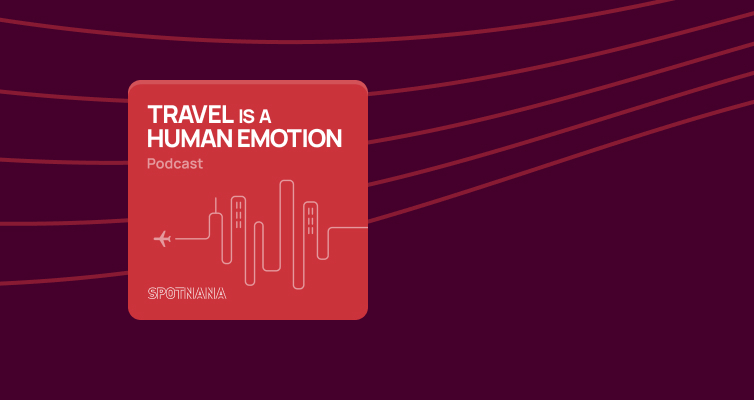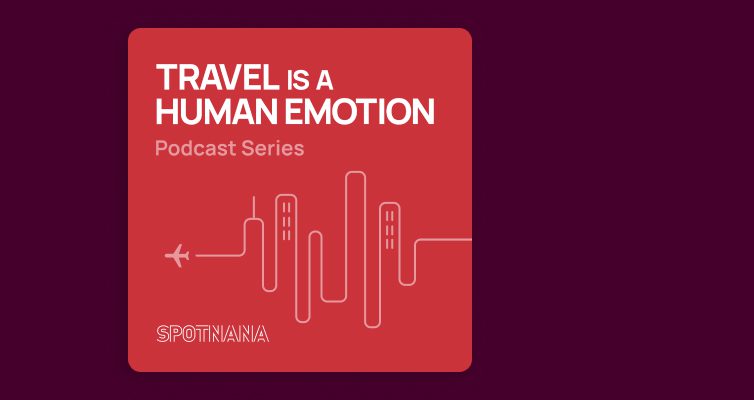Michelle Amos of Qualtrics on smarter business trip decision-making
Guest: Michelle Amos, Associate Director of Travel at Qualtrics
Host: Justin Schuster, VP of Marketing at Spotnana
Length: 27:32
Michelle Amos joins Justin Schuster to discuss her data-backed approach to program improvement, how Gen Z travelers are shifting business travel expectations, and the opportunity for smarter business trip decision-making.
Justin Schuster: Welcome to The Travel Is a Human Emotion Podcast. My name is Justin Schuster, and I’m the VP of Marketing at Spotnana. My guest today, I’m very excited to be spending time with Michelle Amos. Michelle is the Associate Director of Travel at Qualtrics and President of the Puget Sound Chapter of GBTA.
And Michelle, I was wondering if I could kick things off by asking you to describe a little bit about what Qualtrics does, for folks who are unfamiliar?
Michelle Amos: So Qualtrics, for those of you who don’t know, we are an experience management company. Most people probably aren’t familiar with our brand unless they’re familiar with any online survey they take.
We were the first online survey company started in 2004, but we do a lot more with surveys. So we take the data from surveys for our customers. Most of those surveys are around either their client and customer experience or internal surveys, employee satisfaction type of surveys. We also use all the data from our customers to provide benchmarking.
We do social listening and take data from that as well, just to provide a lot of insights where there’s opportunities for our customers to improve their experiences.
Justin Schuster: I have a huge healthy respect for Qualtrics and what you do. I was a product manager years ago competing against Qualtrics and you crushed us all.
I have a huge appreciation for the value of feedback and collecting that and being able to gain insights from that analysis. My question to you is working for a company that focuses on experience management and data collection, how does that impact the way that you manage your travel program?
Michelle Amos: I think we’re in a really unique space for that. So we do really take into account our employee experience, but also really try to balance the travel program budgets, then be fiscally responsible. We recently were acquired by an investment company, so we have a lot more responsibility to produce financials to them in terms of savings, cost avoidance, and just being more fiscally responsible than we were previously.
Also when you think of employee experience, you have to think about your workforce. We do have a little bit of a younger generation of travelers. So that’s been really interesting. I just joined about six months ago and I’m really finally starting to get my hands in the nitty gritty of what’s going on with our travel program and what are those experiences that are providing a great opportunity to our employees? And where do we have that opportunity to improve whether its policy, whether it’s a simple process of how they submit an expense, or the form of payment that we’re using to pay for travel, or vendors that we’re working with that maybe we previously haven’t had a relationship with in the past.
So there’s a lot of work that I’m doing now to understand where we are, what our baseline is, and where those opportunities are to improve. But also where those opportunities to improve for the deliverables that I’m responsible for, ultimately to our executives. I fall under procurement as most travel programs do these days, and I report to the chief procurement officer who reports to the CFO so there’s a lot of visibility to what I do.
Justin Schuster: And so being new to the Qualtrics travel program, is there a lot of building that you’re doing and how are you thinking about 2025?
Michelle Amos: Yes as we launched Spotnana in January of 2024, and this is really year one of having a mandated program. We had one in the past, but coming in just six months, travel was a little bit of a hot potato from the transition of the previous travel manager who left in February to my arrival at the end of June.
So I’m looking at this as a baseline year. I’ve already identified a lot of areas of opportunity. The biggest ones being, where are there ways that I can simplify and streamline the employee process? Not so much their experience when it comes to policies or where they sit on the plane, which is an important one.
Probably the biggest priority that I have been asked to tackle next year: what is it like expensing? What is it like using the booking tool? Is it simple? Is it streamlined? Can they book their perfect trip in 90 seconds or less because they’re not agents? With expensing, the one thing that I am working on is delivering corporate credit cards to our employees, which is a new program.
There are tiny little things that are going to reduce the number of steps they have to do in an expense report. So there’s some of that simplification and streamlining there that I’m hoping will positively impact their experience and then just onboarding vendors and partners that we’ve never worked with in the past, finalizing hotel RFPs right now. That’s, I think, going to be a huge improvement to our travelers.
They’re going to have more choice based on the loyalty that they have to certain brands. And then different airlines we hadn’t partnered with, giving a lot of education on all the benefits of Spotnana. I’m going to champion Spotnana. Of course, we’re a customer and you’re a great partner of ours that they just didn’t know about before due to the change management that didn’t necessarily happen because it’s such a robust process when you change TMCs.
With the departure of my predecessor, there were some gaps there. I’m also working on creating internal resources. So know-before-you-go, user guides, tips and tricks, best practices. And then while working with all our partners to deliver some employee personal travel, or we allow leisure here, which is part of the employee experience, especially for that emerging workforce.
So doing a lot of little things behind the scenes like that.
Justin Schuster: You mentioned that you’re working with some younger travelers. Do they have different interests and needs or requests from the travel program?
Michelle Amos: Yeah, in the industry, just being part of GBTA and also reading a lot from BTN and some of their benchmarks and webinars, and then consulting with my peers and other travel managers, particularly here in the Seattle and Puget Sound Pacific Northwest market, there is a big difference and it really has to do with travelers preference and lack of loyalty.
They don’t necessarily care about the point accumulation with a specific airline, for example, or hotel, they care about those instagrammable moments or those unique experiences that they can have having free bikes at a hotel in downtown Seattle, so they can toodle around and see the city because they’re going to come in a few days early.
The biggest shock for me here, specifically at Qualtrics, is that employees don’t want to use a personal credit card, which boggles my mind, because let me tell you, those points I use for everything. So it’s going to be a huge win. As I mentioned, we’re implementing a corporate card program here for those employees, but then there’s going to be some change management for those of us that love those points on educating around the benefits of Qualtrics, that streamlining experience also for them with submitting expense reports.
The biggest shock, I think, to me, is just how the younger workforce wants to keep their personal and professional lives, if you will, separate to an extent, but then have that crossover with leisure and [social media] likes, let’s get as many likes as we can for having caviar for breakfast type of experiences.
Justin Schuster: As you think about those instagrammable moments, is that affecting the way that you focus on your negotiations with travel suppliers? Are you trying to solve as much for those experiences and the additional amenities as you are for savings? Or how are you thinking of that?
Michelle Amos: Yeah. For hotel RFP what I’ve really looked at is some of the more up-and-coming and modern brands.
There’s a perception across the different hotel chains with those. So those that are a little closer to our offices, maybe than a more traditional brand, really trying to leverage the negotiation power to say, ‘Hey, if you give us a better rate, I’ll ensure a little bit more market share than with your Four Seasons type of brands.’
I’ve also really been pressuring the vendors to provide some type of personal travel discount. There are some airlines out there that have a discount code for X percent off or some of our local negotiated hotels. ‘Hey, if you call in and use a Qualtrics email address, we’ll give you a rate of this.’
So to help that leisure element, and then just coming in, being here for six months, we’re on a calendar fiscal year. So Jan 1, I’m launching all of this information, these resources. I’m going to try and do recurring newsletters.
The travel manager at Columbia Sportswear. I hope it’s okay if I call him out. Jerry Underwood. He does a recurring video blog post slash podcast, two, three minutes that he said has also been very successful. I want to try something like that to connect with that younger workforce as well and provide valuable information for that leisure experience and to give the perception that, ‘Hey, we understand that you’re taking away time from your family, friends, your life to travel on behalf of Qualtrics.’
Sometimes that can be really stressful. When your flight’s delayed four hours and you’re in 52B, let me tell you it feels very personal. So where are some of the little perks that we are trying to help ease that and make you feel valuable, that are a benefit of being part of the Qualtrics family.
Justin Schuster: I love that you’re thinking about the traveler experience so much and thinking about ways that you can improve that and add value. And then on the other hand, you fall under procurement. So you have to wear that other hat and think about cost savings. When you think about the data that you’re trying to use to drive optimization in your program, what KPIs are you solving for the most?
Michelle Amos: That’s a great question. I think being newer, it really has afforded me a great opportunity to take a step back and go, okay, my biggest thing with data. And anyone that’s ever heard me talk about data is always great. My ATP is 500 dollars. So what is my action in my task with that information to optimize my travel program?
So really trying to look at that, getting a baseline of some of those averages, but then what that’s going to help me do is really negotiate better with my vendors as I go into my next year and have that year-over-year trending data. For certain markets, market pairs, property-specific things like that to drive that cost savings.
Right now I’m on target to add about an additional $1 million dollars in savings to our program through some of the negotiations and partnership with Spotnana.
Justin Schuster: That’s tremendous.
Michelle Amos: Another thing that we’re doing, for those individuals that are listening to this that know who Scott Gillespie is.
He is on a pedestal of mine. I know that opens up for a lot of conversations around why and for those of your audience who may not be familiar with him, I just would encourage you to look Scott Gillespie up on LinkedIn. His philosophy around data is actually [identifying] the value of a trip.
So when you look at spend and look at the impact of revenue to that, where is that? So then that can go back to your policy. Are you way out of alignment and you’re spending too much based on the value and ROI you’re getting? Or is there wiggle room to allow premium economy on an eight-hour-plus international flight or whatever it may be.
Of course, the easiest way to start is with sales. I haven’t run across anyone or even Scott himself of how to quantify the value of developers and engineers getting together quarterly for a team meeting [in terms of] of developing a product faster and the impacts to revenue of that product in the market faster.
But that’s a goal of mine, maybe in 2026. I’m importing the data that we’re getting from Spotnana and working with our finance team to see, okay, what is that total cost of a trip and from a budgetary standpoint.
If a manager has, for example, employees based out of Salt Lake, and they have a very large airline that has a headquarters in Salt Lake as a customer. And then they have maybe another customer that is in, let’s just say Detroit, Michigan, for example, let’s say the airline account manager is actually going to Atlanta headquarters, another headquarters every other week. And yet you have the Detroit account manager going once a quarter.
If the Detroit person went monthly and the airline person went monthly, or just tried to meet with the business owners in the Salt Lake area and didn’t travel at all, what would be the impact to the business from a revenue perspective? Could you encourage your reps, coach them, develop them to have more strategic meetings on site that are driving revenue?
And yet you really aren’t impacting your travel spend at all. So what does that look like? That’s something that I’m really trying to work on. And again, starting in January, provide those reports to our people leaders and managers to go. All right. Now you’re equipped with some information. Take it as you will, have those conversations internally, have those conversations with your partners.
Right now they don’t actually have any data, so they have to go to FP&A anyways, who may not have the data for a few weeks, and then it’s behind and not able to be used strategically from that perspective.
Justin Schuster: Scott’s done some really good work on purposeful travel and the justifiable business trip framework that he’s put together.
And I think his analysis showed that there’s something like 25, 30 percent of business trips that could be eliminated without any significant impact to the business.
Are you thinking about implementing a pre-trip approval process to help focus on those high-value trips? In addition to looking at the data and helping to advise individual travelers around what travel patterns might be most valuable and effective.
Michelle Amos: So interesting. We can’t necessarily program the approval today based on reason for travel, but our policy next year is going to say, if you’re traveling internally, you’re strongly encouraged to book all travel 21 days in advance because 99 percent of the time, [you know about] these internal meetings at least three weeks in advance for the majority of folks.
So we’re going to be doing that to try and see if we can help corral some things and then loosen up the advanced purchase requirement for customer travel, right? If I tell my Spotnana help manager, I want you here next week. She loves me. She’ll be here next week supporting me in that way.
So we want to make sure we’re doing that for our customers right now. We do have a hard-stop approval in place, but that’s something that I’m thinking about. I’m floating around the option of, do we want to move more to a soft approval? I’ve also talked with some of my colleagues locally here, other travel managers that they’re looking at and exploring that option as well.
One of them most likely will be implementing that next year. So that tells me, from an employee perspective and the experience, there’s going to be some improvement there as an industry. Overall, there’s some benchmarking we have, and there’s still going to be some controls visibility and ways that we’re not going to see our spending dramatically increase for this. and
At the end of the day, I’m not the budget police and I don’t want to be at home. Here at the office, it’s the responsibility of people leaders to decide what is their budget and to stay within that. And if there’s a justified need that they need to have a trip book less in advance, or their employee wants to stay at the Four Seasons then go ahead and do that [based on] the needs of your business.
Justin Schuster: And that’s a great orientation to have to help educate people about how to make wonderful decisions for the business, but not necessarily have to be in the position of enforcing all of that all on your own.
Michelle Amos: Yeah, and it’s a lot for our managers.
Our approval process is that it goes to the person’s manager, and we’re all busy. We’re in meetings and that’s a little bit of a roadblock from an experience perspective of whether the manager has so much work to do already. They have to then go in review. Does this make sense? Etcetera.
Then if they don’t action it in time, that ticket price could be lost. Then we are paying more money. Is it a double-edged sword? I don’t know.
Justin Schuster: You can make some changes and test and learn and see what works the best for your employees and your culture.
Michelle Amos: It’s just travel.
I had a wise mentor once tell me we’re not saving lives. And it’s okay. So we test and learn. It’s not a failure. It’s a first attempt in learning.
Justin Schuster: When you think about other opportunities for innovation in your travel program, are there specific technologies that you’re excited to incorporate over the next few years? What’s top of mind?
Michelle Amos: AI, I think is everybody’s top of mind. And when it first emerged on the scene, it was the chatbot with agents, right? And how are we streamlining contacts to agents ensuring that what could be self serviced is done that way so there’s more availability for agents and a better traveler experience.
But now, as it’s really evolved, it’s looking at how it can create the perfect trip. Can it forecast the needs of what you want? You just say, Hey, Alexa, or whoever it is, right? You’re talking to book my trip to Salt Lake, which is where one of Qualtrics’ headquarters is.
I think that’s going to be interesting. The insights it’s going to bring to data is going to be huge and that actionable data, which is a pillar of a program metric for me. I was just moderating a panel a few weeks ago at our GBTA Puget Sound chapter, and we had an airline talk about how they’re using AI to actually plan the routing of their flight paths.
My dad was a captain for many years and I remember going into the crew room and then rolling out maps that were huge and they had to chart their course. They then had to look at the NOAA weather forecast. Are we going to have to fly around this thunderstorm cell? Now all of that is happening through AI.
So one, it’s going to be much more accurate. It’s going to ensure from a sustainability perspective, the most efficient route. And two, it’s going to ultimately reduce staffing costs because the crew, their pay clock is paid hourly. Some people may not realize that as soon as they start that process of planning.
So to reduce that time, and then those cost savings, you best believe my vendor partners and I are going to have conversations around, ‘All right. I know you’re getting some [savings]. So let’s send those savings percentages down the ladder.’
Justin Schuster: There’s so many opportunities for AI to add value.
And I know we’re looking at a number of those. And on the flight route side, that’s not an area that we necessarily specialize in. But I saw that IATA is also now working with some airlines to pull turbulence data so that flight routes can be optimized based on that insight as well. So lots of great things are coming down the pipe.
Since this is The Travel Is a Human Emotion podcast, let me ask just in closing, when you reflect on the connection between travel and human emotions, what comes to mind most for you?
Michelle Amos: What comes most to mind for me [is that] my travelers are my customers, right? What’s their experience: do they feel valued as an employee when their flight has been delayed three hours, they’re in 52B, and they’re missing their child’s holiday recital, right?
Making sure that our policies are lenient enough that they’re not feeling like a sardine, that they can sit closer towards the front of the aircraft so they can be one of the first off to get home as soon as they land, since their flight has been delayed. And not having to wait so that they are well rested so they don’t have any kind of immune compromise from getting sick because their bodies are worn out from travel.
I’m not sure how many people are aware of this, it’s actually a top five reason for voluntary attrition within organizations. They need to be cared for and they view it as something that’s very emotional for them. Most people, when they take voluntary leave, it’s driven by some type of emotion, right? Whether it’s a want in Maslow’s hierarchy of needs of getting higher salaries so that you can provide a better life for your family, or more fulfillment in your job and what your tasks are.
Travel is very much like that. The more that organizations realize that it goes back to making those trips more effective, generating more revenue, and then even as the industry evolves, supporting our peers, our supplier vendors, and making us really a community and a connected community and for the world at large.
We are one of the most impacted industries with sustainability, maybe reducing our travel patterns or changing it to help [offset] the carbon emissions that we’re producing there. That’s huge too. And all of that comes back to making it feel very personal and the impact that you have in the world.







